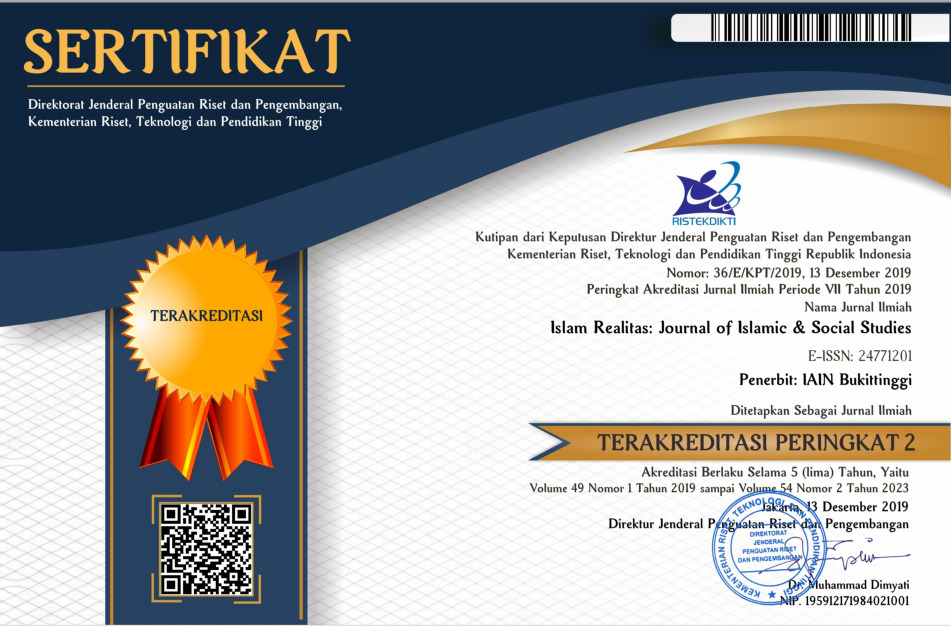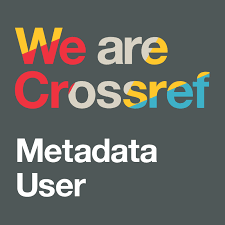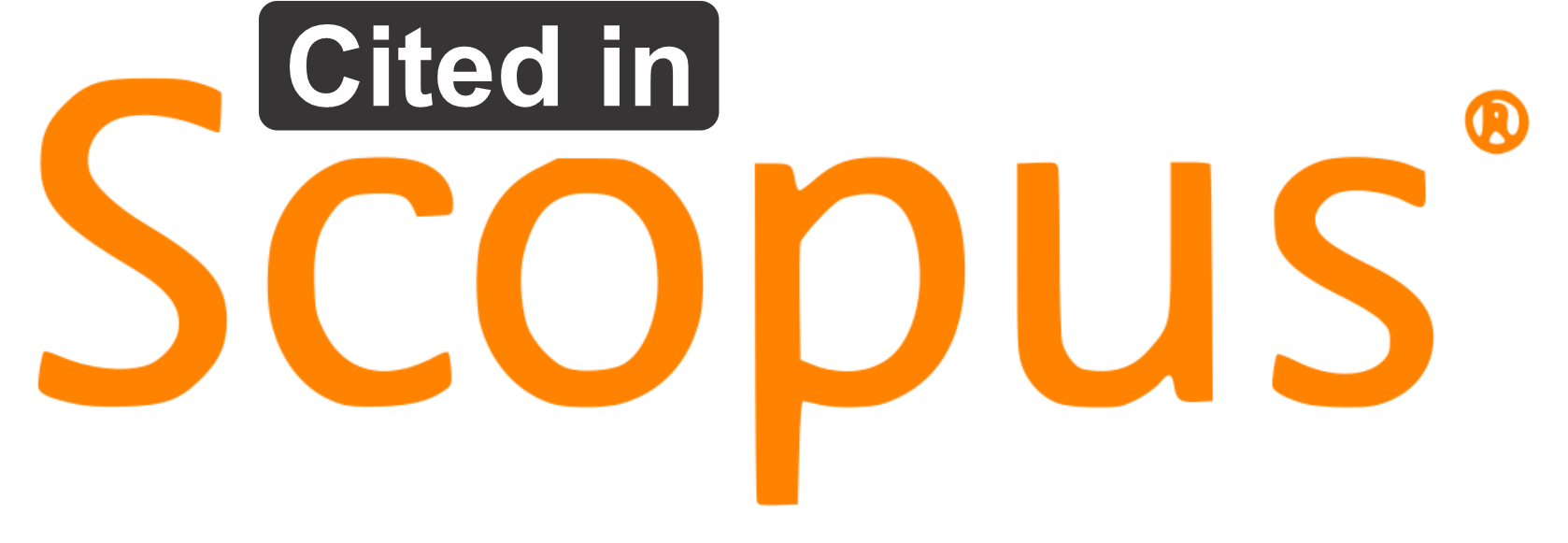Identifying Radicalism Potential in Senior High School Students in Riau Province
Downloads
This study aims at identifying the radicalism potential in senior high school students or equivalent levels including secondary schools and vocational schools in Riau Province. This study uses a survey design involving 230 students selected through random sampling consisting of 65 senior high school students, 100 vocational high school students, and 65 Islamic senior high school students. The collected data were analyzed qualitatively and quantitatively. The findings showed the radicalism potential of 20% in secondary school students, of 30.5% in vocational school students, and of 19.8% in Islamic secondary school students. Around 23.4% of the students were identified to have radicalism potential such as having fundamentalist behavior. The percentage obtained in this study is hoped to encourage the teaching of religious tolerance, universal morality, and formal education. Another implication for the people who are related to the education of youth is that they should pay more attention more to difficult social issues, especially those that are relevant to the use of social media.
Penelitian ini bertujuan untuk mengidentifikasi potensi radikalisme pada siswa SMA/MA di Provinsi Riau. Designm penelitian ini menggunakan survey melibatkan 230 siswa yang diambil secara random sampling yang terdiri dari 65 siswa SMA, 100 siswa SMK, dan 65 SMA Islam. Data yang terkumpul dianalisis secara kualitatif dan kuantitatif. Hasil penelitian menunjukkan potensi radikalisme pada siswa SMA 20%, siswa SMK 30,5%, dan siswa MAN Islam 19,8%. Sekitar 23,4% siswa diidentifikasi memiliki potensi radikalisme seperti berperilaku fundamentalis. Persentase yang didapat dalam penelitian ini kurang sehingga diharapkan dapat dilaksanakan pengajaran tentang pentingnya toleransi beragama, akhlak, dan pendidikan formal. Implikasi lain bagi masyarakat yang terkait denganperan pemuda harus lebih memperhatikan kisruh yang ada, terutama yang relevan dengan penggunaan media sosial di era milenial ini
Books
Harahap, Syahrin. Upaya Kolektif Mencegah Radikalisme & Terorisme Edisi Pertama. Jakarta: Siraja, 2017.
Inbar, Efraim, and Bruce Maddy-Weitzman. Religious Radicalism in the Greater Middle East. Routledge, 2013.
Journals
Adnan, Muhammad, and Anita Amaliyah. “Radicalism Vs Extremism: The Dilemma of Islam and Politics in Indonesiaâ€. Jurnal Ilmu Sosial. Vol. 20 no. 1 (2021), p. 24–48. https://doi.org/10.14710/jis.20.1.2021.24.
Arif, Muhamad. “Revitalisasi Pendidikan Aswaja an Nahdliyah (Ke-Nu-an) dalam Menangkal Faham Radikalisme di SMK Al-Azhar Menganti Gresikâ€. J-PAI: Jurnal Pendidikan Agama Islam. Vol. 5 no. 1 (2018), p. 15–25. https://doi.org/10.18860/jpai.v5i1.6052.
Aryanti, Zuzy et al. “Persepsi dan Ketahanan Aktivis Muslim Kampus Terhadap Paham dan Gerakan Islam Radikal (Studi Pada Perguruan Tinggi di Propinsi Lampung)â€. PENAMS. Vol. 16 no. 1 (2018).
Awad, N. G. “The InjÄ«liyyÅ«n’s Presence and Role in the Land of Islam: Intellectual and Contextual Analysisâ€. After-Mission, Beyond Evangelicalism., 2020, 232–281.
Boeke, Sergei. “Al Qaeda in the Islamic Maghreb: Terrorism, Insurgency, or Organized Crime?â€. Small Wars and Insurgencies. Vol. 27 no. 5 (2016), p. 914–936. https://doi.org/10.1080/09592318.2016.1208280.
Bolet, D. “Drinking Alone: Local Socio-Cultural Degradation and Radical Right Support—the Case of British Pub Closuresâ€. Comparative Political Studies. Vol. 54 no. 9 (2021), p. 1653–1692.
Cahyono, Heri, and Arief Rifkiawan Hamzah. “Upaya Lembaga Pendidikan Islam dalam Menangkal Radikalismeâ€. At-Tajdid. Vol. 2 no. 1 (2018).
Choi, Jeong Ja et al. “University Students’ Perception to Online Class Delivery Methods during the COVID-19 Pandemic: A Focus on Hospitality Education in Korea and Malaysiaâ€. Journal of Hospitality, Leisure, Sport and Tourism Education. Vol. 29 no. November 2020 (2021), p. 100336. https://doi.org/10.1016/j.jhlste.2021.100336.
Fuad, A. Jauhar. “Gerakan Kultural dan Pemberdayaan: Sebuah Imun Atas Radikalisasi di Sanggar Sekar Jagad Di Sukoharjoâ€. Al-Tahrir: Jurnal Pemikiran Islam. Vol. 18 no. 1 (2018), p. 1–22. https://doi.org/10.21154/altahrir.v18i1.1171.
Hammad, Ahmad Mohammad Al. “Radikalisme di Kalangan Mahasiswa Surabaya (Studi Kasus Kreteria Radikalisme Menurut Yusuf Al-Qardhawi)â€. Universitas Islam Negri Sunan Ampel., 2018 https://doi.org/10.1051/matecconf/201712107005.
Heath-Kelly, Charlotte. “The Geography of Pre-Criminal Space: Epidemiological Imaginations of Radicalisation Risk in the UK Prevent Strategy, 2007–2017â€. Critical Studies on Terrorism. Vol. 10 no. 2 (2017), p. 297–319. https://doi.org/10.1080/17539153.2017.1327141.
Hidayat, Hamdan. “Radikalisme Agama Perspektif Al-Qur’anâ€. Madani Jurnal Politik dan Sosial Kemasyarakatan. Vol. 13 no. 1 (2021), p. 1–25. https://doi.org/10.52166/madani.v13i1.2287.
Idid, Syed Arabi et al. “News Diffusion of a Significant Event: How Malaysians and Indonesians Learnt of the Indonesia Airasia Qz8501 Tragedyâ€. Asian Journal of Applied Communication. Vol. 8 no. 2 (2018).
Ikhwanuddin. Perkembangan Radikalisme di Indonnesia dan Efektifitas Penanggulangannya : Studi Kasus di Bima Edited by A. Tajus Subeky. Bandung: Genta Publishing, 2021.
Kasdi, Abdurrohman. “Fundamentalisme dan Radikalisme dalam Pusaran Krisis Politik di Timur Tengahâ€. Jurnal Penelitian. Vol. 12 no. 2 (2018), p. 379–402.
Llorent-Bedmar, Vicente et al. “Islamic Religion Teacher Training in Spain: Implications for Preventing Islamic-Inspired Violent Radicalismâ€. Teaching and Teacher Education. Vol. 95 (2020) https://doi.org/10.1016/j.tate.2020.103138.
Ma’arif, Syamsul. “Reinventing Pesantren’s Moderation Culture to Build a Democratic Society in the Post-Reform Republic of Indonesiaâ€. Pertanika Journal of Social Sciences and Humanities. Vol. 27 no. 3 (2019), p. 1739–1751.
Mas’ud, Ali et al. “Program Penalaran Islam Indonesia Dan Gerakan Kontra-Radikalismeâ€. Jurnal Pendidikan Agama Islam (Journal of Islamic Education Studies). Vol. 6 no. 2 (2019), p. 175–202. https://doi.org/10.15642/jpai.2018.6.2.175-202.
Nasution, Hasnah, and Al Rasyidin. “Respons Al-Ittihadiyah di Sumatera Utara Terhadap Radikalismeâ€. Journal of Contemporary Islam and Muslim Societies. Vol. 3 no. 1 (2019), p. 1–35. https://doi.org/10.30821/jcims.v3i1.3375.
Nugroho, Puspo. “Internalization of Tolerance Values in Islamic Educationâ€. Nadwa : Jurnal Pendidikan Islam. Vol. 12 no. 2 (2018), p. 197–226.
Pace, Michelle. “Paradoxes and Contradictions in EU Democracy Promotion in the Mediterranean: The Limits of EU Normative Powerâ€. Democratization. Vol. 16 no. 1 (2009), p. 39–58. https://doi.org/10.1080/13510340802575809.
Putra, Idhamsyah Eka, and Zora A. Sukabdi. “Basic Concepts and Reasons behind the Emergence of Religious Terror Activities in Indonesia: An inside Viewâ€. Asian Journal of Social Psychology. Vol. 16 no. 2 (2013), p. 83–91. https://doi.org/10.1111/ajsp.12001.
Rahmatullah, Yuminah. “Radicalism, Jihad and Terrorâ€. Al-Albab. Vol. 6 no. 2 (2017), p. 157. https://doi.org/10.24260/alalbab.v6i2.731.
Rofiq, Muhammad Husnur, and Riza Ahmad Ridwan. “Menangkal Radikalisme Melalui Pendidikan Agama Islam Berbasis Aswaja Nahdlatul Ulamaâ€. Andragogi: Jurnal Ilmiah Pendidikan Agama Ilslam. Vol. 1 no. 1 (2019), p. 1–14.
Rokhmad, Abu. “Radikalisme Islam dan Upaya Deradikalisasi Paham Radikalâ€. Walisongo: Jurnal Penelitian Sosial Keagamaan. Vol. 20 no. 1 (2012), p. 79–114. https://doi.org/10.21580/ws.20.1.185.
Rubaidi. Radikalisme & Populisme Islam di Era Post Truth : Tantangan Demokrasi Indonesia. Surabaya: CV. Imtiyaz, 2021.
Sartika, Kartini Dwi et al. “Analisa Upaya Counter-Radicalism di Kalangan Kampus Menggunakan Pendekatan CMM (Coordinated Management of Meaning)â€. Ikraith-Humaniora. Vol. 3 no. 2 (2019), p. 31–38.
Sarwar, Binesh et al. “Usage of Social Media Tools for Collaborative Learning: The Effect on Learning Success With the Moderating Role of Cyberbullyingâ€. Journal of Educational Computing Research. Vol. 57 no. 1 (2019), p. 246–279. https://doi.org/10.1177/0735633117748415.
Susanto, Nanang Hasan. “Menangkal Radikalisme Atas Nama Agama Melalui Pendidikan Islam Substantifâ€. Nadwa: Jurnal Pendidikan Islam. Vol. 12 no. 1 (2018), p. 65–88. https://doi.org/10.21580/nw.2018.12.1.2151.
Taufani. “Pemikiran Pluralisme Gusdurâ€. Jurnal Dakwah Tabligh. Vol. 19 no. 2 (2018), p. 198–217. https://doi.org/10.24252/JDT.V19I2.7475.
Thoyyib, M. “Radikalisme di Indonesiaâ€. TA‟LIM : Jurnal Studi Pendidikan Islam. Vol. 1 no. 1 (2018), p. 90–105.
Utomo, Cahyo Budi, and Wasino. “An Integrated Teaching Tolerance in Learning History of Indonesian National Movement at Higher Educationâ€. Journal of Social Studies Education Research. Vol. 11 no. 3 (2020), p. 65–108.
Varol, Cigdem, and Emrah Söylemez. “Border Permeability and Drivers of Cross-Border Cooperation in The Turkish and Eu Border Regionâ€. KnE Social Sciences. Vol. 1 no. 2 (2017), p. 87. https://doi.org/10.18502/kss.v1i2.649.
Widyana, I Komang et al. “ Religious Moderation in the Framework of Bhinneka Tunggal Ika in Indonesia â€. Proceedings of the Annual Civic Education Conference (ACEC 2021). Vol. 636 no. Acec 2021 (2022), p. 166–169. https://doi.org/10.2991/assehr.k.220108.029.
Widyaningrum, Anastasia Yuni, and Noveina Silviyani Dugis. “Terorisme Radikalisme dan Identitas Keindonesiaanâ€. Jurnal Studi Komunikasi (Indonesian Journal of Communications Studies). Vol. 2 no. 1 (2018), p. 32–67. https://doi.org/10.25139/jsk.v2i1.368.
Yumitro, G et al. “The Threat of Terrorism in the Malang Region, Indonesiaâ€. Intellectual Discourse. Vol. 28 no. 2 (2020), p. 779–791. https://doi.org/10.33383/2020-2.
Online Resources
Arjulin. “Peran Forum Koordinasi Pencegahan Terorisme (FKPT) dalam Pencegahan Paham Radikalisme dan Terorisme di Sumatera Selatanâ€. Universitas Islam Negeri Raden Fatah Palembang, 2018 (On-line), tersedia di: http://eprints.radenfatah.ac.id/2737/ (2018).
Mahrus, E et al. “Messages of Religious Moderation Education in Sambas Islamic Manuscriptsâ€. Madania: Jurnal …., 2020 (On-line), tersedia di: https://ejournal.iainbengkulu.ac.id/index.php/madania/article/view/3283 (2020).
Authors who publish with this journal agree to the following terms:
- Authors retain copyright and grant the journal right of first publication with the work simultaneously licensed under a Creative Commons Attribution License that allows others to share the work with an acknowledgment of the work's authorship and initial publication in this journal.
- Authors are able to enter into separate, additional contractual arrangements for the non-exclusive distribution of the journal's published version of the work (e.g., post it to an institutional repository or publish it in a book), with an acknowledgment of its initial publication in this journal.
- Authors are permitted and encouraged to post their work online (e.g., in institutional repositories or on their website) prior to and during the submission process, as it can lead to productive exchanges, as well as earlier and greater citation of published work (See The Effect of Open Access).









